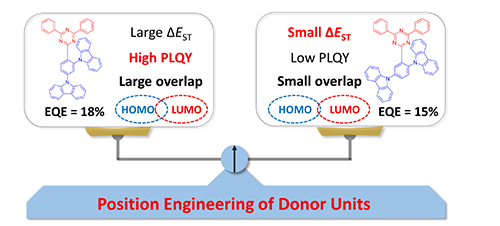摘要/Abstract

利用咔唑作为给体基元、三嗪作为受体基元,通过有效组合和位点调控设计合成了两个发光机理-热活化延迟荧光(TADF)分子:m-CzTri和p-CzTri.这两个材料均发射明亮的蓝色荧光,且具有非常小的单线态-三线态激子分裂能.计算模拟表明,给体和受体基团分离了最高占据轨道(HOMO)和最低未占据轨道(LUMO),使它们之间交叠很小.此外,测试了它们的热学、电化学、光物理和器件性质,其中,m-CzTri作为发光分子的有机发光二极管(OLED)器件的色坐标为(0.15,0.25),得到了高达18%的外量子效率.
关键词: 热活化延迟荧光, 咔唑, 三嗪, 蓝光发光分子, 有机发光二极管
Using carbazole as the donor motif, triazine as the acceptor motif, two thermally activated delayed fluorescence (TADF) molecules of m-CzTri and p-CzTri were designed and synthesized through efficient combination and position regulation. Both materials emit bright blue fluorescence with very small singlet-triplet splitting energy. Computational simulations show that the donor and acceptor groups are well separated from the highest occupied orbit (HOMO) and the lowest unoccupied orbit (LUMO). In addition, their thermal, electrochemical, photophysical, and device properties were tested. Among them, the color coordinates of organic light emitting diode (OLED) devices with m-CzTri as the emitter were (0.15, 0.25), and the external quantum efficiency was as high as 18%.
Key words: thermal activated delayed fluorescence, carbazole, triazine, blue emitter, organic light emitting diodes
PDF全文下载地址:
点我下载PDF
